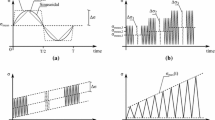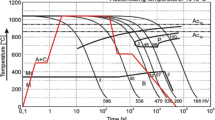Abstract
This paper provides description and results from an investigation aimed to determine whether loading histories specific to marine and offshore structures cause shakedown of compressive residual stress produced by high-frequency mechanical impact (HFMI) treatment and therefore affect fatigue resistance of welded joints improved by these methods. Fatigue tests were carried out to investigate the influence of compressive fatigue loads on fatigue strength of non-load carrying specimens with transverse attachments subjected to ultrasonic impact treatment (UIT). It was found that significant relaxation of compressive residual stresses is achieved under application of compressive cycles in fatigue testing. It was also observed that not only the magnitude of the applied compressive stress/mean stress affects relaxation of the compressive residual stress but also the number of applied compressive cycles. This relaxation may reduce the beneficial effect of HFMI treatment under application of load histories specific to marine structures.















Similar content being viewed by others
References
Marquis GB, Barsoum Z (2013) Fatigue strength improvement of steel structures by HFMI: proposed procedures and quality assurance guidelines. Welding World. doi:10.1007/s40194-013-0077-8
Barsoum Z, Marquis GB, Mikkola E, Yildirim HC (2013) Fatigue strength improvement of steel structures by high-frequency mechanical impact: proposed fatigue assessment guidelines. Welding World 57(6):803–822
Leitner M, Stoschka M, Eichlseder W (2013) Assessment of HFMI post-treated joints by the notch stress approach. In: Aubin V, Courtin S, Koster A (eds) Proceedings of the 13th International SF2M Spring Meeting, Paris, pp 90–102
Mikkola E, Doré MJ, Khurshid M (2013) Fatigue strength of HFMI treated structures under high r-ratio and variable amplitude loading. Proc Eng 66:161–170
Mori T, Shimanuki H, Tanaka M (2012) Effect of UIT on fatigue strength of web-gusset welded joints considering service condition of steel structures. Welding World 56(9–10):141–149
Statnikov ES, Muktepavel VO, Blomqvist A (2002) Comparison of ultrasonic impact treatment (UIT) and other fatigue life improvement methods. Welding World 46(3-4):28–39
Roy S, Fisher JW, Yen BT (2003) Fatigue resistance of welded details enhanced by ultrasonic impact treatment (UIT). Int J Fat 25(9–11):1239–1247
Yildirim HC, Marquis GB (2013) A round robin study of high-frequency mechanical impact (HFMI)-treated welded joints subjected to variable amplitude loading. Welding World 57(3):437–447
Yildirim HC, Marquis GB, Barsoum Z (2013) Fatigue assessment of high frequency mechanical impact (HFMI)-improved fillet welds by local approaches. Int J Fat 52:57–67
Yin D, Wang D, Jing H, Huo L (2010) The effects of ultrasonic peening treatment on the ultra-long life fatigue behavior of welded joints. Mater Des 31(7):3299–3307
Common Structural Rules for Bulk Carriers and Oil Tankers (2014) IACS, London
Weich I, Ummenhofer T, Nitschke-Pagel Th, Dilger K, Eslami H (2009) Fatigue behaviour of welded high-strength steels after high frequency mechanical post-weld treatment. Welding World 53(11–12):R322–R332
Lopez Martinez L, Haagensen PJ (2007) Life extension of class F and class F2 details using ultrasonic peening, IIW. IIW document XIII-2143- 07
Haagensen PJ, Maddox SJ (2013) IIW recommendations on post weld fatigue life improvement of steel and aluminium structures. Woodhead Publishing Ltd., Cambridge
Okawa T, Shimanuki H, Funatsu Y, Nose T, Sumi Y (2013) Effect of preload and stress ratio on fatigue strength of welded joints improved by ultrasonic impact treatment. Welding World 57(2):235–241
Lotsberg I, Fjeldstad A, Helsem MR, Oma N (2014) Fatigue life improvement of welded doubling plates by grinding and ultrasonic peening. Welding World 58(6):819–830
Lloyd’s Register of Shipping (2013) Rules for the manufacture, testing and certification of materials. Lloyd’s Register, London
James JA, Santisteban JR, Edwards L, Daymond MR (2004) A virtual laboratory for neutron and synchrotron strain scanning. Physica B 350:743–746
Kim JC, Cheong SK, Noguchi H (2013) Residual stress relaxation and low- and high-cycle fatigue behavior of shot-peened medium-carbon steel. Int J Fat 56:114–122
Hobbacher A (2009) IIW recommendations for fatigue design of welded joints and components. WRC, New York
Acknowledgments
We would like to thank the UK Science and Technology Facilities Council for the provision of beamtime at the ISIS neutron source. BA and MEF are grateful for funding from the Lloyd’s Register Foundation, a charitable foundation helping to protect life and property by supporting engineering-related education, public engagement and the application of research.
Author information
Authors and Affiliations
Corresponding author
Additional information
Doc. IIW-2530-14, recommended for publication by Commission XIII “Fatigue of Welded Components and Structures”.
Rights and permissions
About this article
Cite this article
Polezhayeva, H., Howarth, D., Kumar, M. et al. The effect of compressive fatigue loads on fatigue strength of non-load carrying specimens subjected to ultrasonic impact treatment. Weld World 59, 713–721 (2015). https://doi.org/10.1007/s40194-015-0247-y
Received:
Accepted:
Published:
Issue Date:
DOI: https://doi.org/10.1007/s40194-015-0247-y




